That Time I Played Chef at the CIA
My two-day culinary romp through the teaching kitchens of the Culinary Institute of America
I’m an experienced scratch cook. I’ve done my 10,000 hours in the kitchen, maybe 10,000 hours chopping onions. I have decent knife skills and keep them sharp (skills and knives). I cook without recipes 99 percent of the time and nobody’s died yet. But I have zero professional training, so when I got a cold call from the PR arm of the Culinary Institute of America inviting me to participate in a cooking Boot Camp, gratis, I pounced.
Boot Camps are two- to five-day culinary immersions held the CIA’s campuses in Hyde Park, Napa, and San Antonio. The training regimen is billed as a rigorous all-day affair, and topics span the gamut: breads, pastry, Mediterranean, bistro, grilling, vegetarian, wine country cuisine—you get the drift. Camps are aimed at enthusiastic amateur cooks who want to experience professional-grade training, and they’re taught by the same faculty, in the same classrooms, that support the school’s degree programs.
I was naturally drawn to the wine-related options, but California is a schlep, so Hyde Park it was. I was hoping for the three-day bistro session because it seemed right for a wine journalist in love with France. Instead, the PR people steered me toward a two-day session on hors d’oeuvres, and I consented, because, after all, nobody eats hors d’oeuvres without wine, at least not at my house.
I recruited a friend to join me (not gratis), one of the best home cooks I know. She’d contemplated attending culinary school instead of college but had been put off the path by a male instructor. Women will never be accepted in professional kitchens, he told her. It’ll be an uphill slog. You will never be happy. The dispiriting advice seemed avuncular at the time, but on reflection was likely gatekeeping, tout court.
We drove over a day early and checked into a suite at a hotel-motel in Poughkeepsie. The next day we rose at 5:15 a.m. and by 5:45 were wending our way toward Roth Hall, the colonnaded centerpiece of the school’s instructional facilities. Students in chef’s whites shuffled silently among us, bright ghosts in the dark October morning. It was early for us but not for them, because here the propane’s always burning. Students cook around the clock, just as they will, someday, in the kitchens of real life.
We registered and greeted our twenty-odd classmates. Our instructor (“call me Chef!”) herded us into a lecture room and handed out binders with the recipes we’d be cooking over the next two days. Chef was older, gray-haired, a blocky don robed in white who presided with dictatorial zeal. He walked us through the sheaf of recipes, reading aloud the particulars of each dish. There were crab cakes with rémoulade, sun-dried tomato and goat cheese tartlets, fig and walnut bruschetta, roast beef and Stilton tea sandwiches, and so much more. Some recipes were complicated but the instructions seemed clear enough.
We retreated to restrooms to don blousy chef’s whites and Tyvek toques. Chef paraded us into the big teaching kitchen, gave an orientation to the equipment, and divided us into small groups, assigning five recipes to each team. Go forth and cook. And make sure it’s ready by lunch.
We stood blinking at our prep stations. I’d expected more preamble, a bit of instruction. How to roll a perfect Swedish meatball. The proper way to make pâte brisée. Nifty tricks for crafting garnishes that look like tiny birds. Something.
My team huddled over the paperwork. In hindsight we might have divided the tasks, with one person to chop, another to run the cooktop, a third to staff the oven. But the time pressure led us to a decidedly amateur fallback: divvy the recipes and get cracking. I signed up for sun-dried tomato tartlets and smoked trout canapés. Someone else toddled off to figure out gougères from pâte à choux (which Chef charmingly pronounced “patty shoo”). Two of our team had only a single recipe but one of them was a doozy: hand-made mozzarella, Prosciutto, and sun-dried tomato roulade.
We bumbled into one another as we peeled and diced, rolled and tied, broiled and braised and fried and baked, trying not to drag our sleeves through the sauce. Chef bellowed instructions and time-calls over the din.
Thank heaven for the students. Assisting were three managers-in-training, second-year culinary students who’d been recruited for their talent, leadership, and breezy aplomb with dilettantes like us. This was their home kitchen, and not only did they know where everything was and how to use it, they had serious culinary chops. They gave advice, demonstrated techniques, and stepped in when things started to go awry. One of them, a dimpled sprite named Casey, could roll a mean dumpling.
I made the trout canapés first. These were easy, just little triangles of toasted rye topped with horseradish butter and flaked trout. The tartlets were a bigger production. The instructions said to cut rounds of puff pastry, press them into the diminutive cups of a tart pan, then top this with a second tart pan to weight the shells during baking. There was only one problem: there was only one tart pan.
“Just use baking beans!” Chef thundered. I rummaged the pantry for the stock of dried beans, parceled them into the tiny cups, and slung the pan into the oven. There were no timers in this professional kitchen, so I kept a few neurons ticking my head while I turned to make the filling. After about five minutes, I cracked the door to check my shells.
Puff pastry is so-called because it puffs. My little shells had ballooned and popped, catapulting beans throughout the scorching cavity. The few beans that remained were now encased in a golden envelope of buttery starch.
“Next time, just use foil,” Casey whispered, stifling amusement.
Chef noticed our tittering, and, possibly chagrined and not having told me to add a layer of parchment first, came over to help pick beans out of pastry. At last I piped the shells with filling, slid them back into the oven, and tried to blot visions of missed beans precipitating a dental emergency.
Finally, with a clatter of pans, we were done. We set our creations onto serving dishes and arrayed them on a long table, then stood back, sweat-soaked and splattered, to admire our creations. At the CIA, students eat what students cook. The bakery class makes breads for the dining halls, the banquet class feeds a horde, the fine dining students serve guests at the campus restaurants. Our lunch was twenty different hors d’oeuvres.
After, we decamped to the classroom to receive a lecture on cheese. “Milk wants to be cheese!” Chef proclaimed, diagramming the category’s ample diversity and myriad fine qualities, and demonstrating how to select and arrange a proper cheese plate. I was prepared for another round in the kitchens (it was a boot camp, after all), but we simply adjourned for the day at 3 p.m.
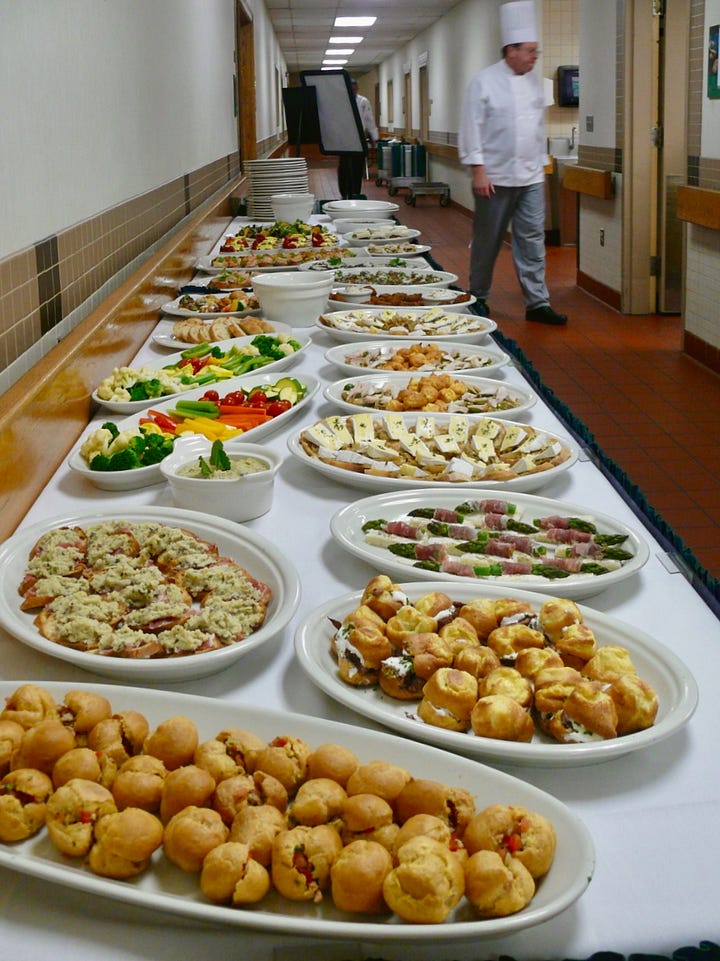

Day Two was more of same: a mad morning scramble to create assigned recipes, a 2,000-calorie lunch, and a lecture. Chef did offer more demos on the second day—on turning a vegetable, making scallion pancakes, and stuffing dim sum dumplings. By now we were more accustomed to the kitchens so our mistakes were fewer and less hilarious. We knew were to find the strainers and sheet pans and tasting spoons, what to do (and not to do) with our side towels, and how to twiddle the knobs on the ranges so as not to burn the butter.
But by the end of two days we’d done only about six hours of hands-on cooking. Given the CIA’s lofty perch in the pantheon of American cooking schools, I’d expected the instruction to be a little more—comprehensive, more like training. “I didn’t come here to chop vegetables,” my friend (the paying customer) grumbled, “or to cook from a recipe. I already know how to do that.” She’d expected more insights about the structure of the dishes, how each element affects flavor and impact. Maybe tips on substitutions, or for fine-tuning a dish to transform it from “nice” to “knockout.”
It’s conceivable the Boot Camp formula works brilliantly for most attendees, adults who are unaccustomed to being on their feet all day, unaccustomed to cooking without recipes, unaccustomed to being in school at all. But in the end it wasn’t training. It was vacation, albeit one with a 6 a.m. roll call.
Still, reflecting on my experience, I did win a handful of useful take-aways:
1. Hors d’oeuvres are flavorful and salty for a reason. Wine was implicated (if not served) at Boot Camp; we learned that hors d’oeuvres are strongly flavored and salty to help them pair with adult beverages. Flavor piques appetite, salt piques thirst, and wine piques curiosity in one’s fellow humans.
2. Canapé means “couch,” one upon which delights repose. A canapé consists of a starchy base—bread, crostini, fried polenta—slathered with spread and layered with topping and garnish. The spread serves as glue to keep the goodies stuck to the couch, the culinary equivalent of binge-watching Netflix.
3. “Mise en place means get your act together!” Not really. But Chef repeatedly trumpeted this line to encourage mindful prep. The literal translation is “put in place” and refers to setting up one’s workstation with the chopped, shredded, sliced, diced, crumbled, and minced ingredients needed before the cooking dance begins. I’d always been lackadaisical about mise, especially for weeknight suppers. For big dinner parties I’m a new convert, because “Getting my act together” leaves more time for guests.
4. Use a scrap tray. I cook with a lot of vegetables, accumulating a colorful mess of parings and trimmings, stems and seeds and piths and peels, next to my cutting board. After dinner, my scullery staff—er, husband—scrapes the slop into a shallow bowl to transport it to the compost. Why not put the stuff into a bowl in the first place? Duh.
5. Use a side towel. A professional chef keeps a fresh towel handy (often tucked into an apron) for wrapping hot pot handles, pulling trays from the oven, or grasping slippery fish. For safety’s sake these must stay clean and dry; the side towel is not, Chef exhorted, a wiping rag. We wipe with another rag, the one in the sanibucket. Keep these separate to keep your sanity (and Chef’s).
6. Choke up on the knife. My most-used kitchen tool is my professional-grade chef’s knife, and I’m pretty handy with it. But watching me chop, Chef sidled up and suggested I choke up on the handle for more power. I was skeptical at first because it seemed it might compromise leverage, but I’ve since adopted this far better approach.
7. Taste it. “Get rid of your middle name and put ‘taste’ in there!” roared Chef, as he pulled a clean teaspoon from one of the canisters accessorizing each workstation, dipped it into a saucepan of Thai green curry, and slurped. “Taste, taste, taste!” Making meatballs? Season the meat, then roll one meatball and cook it—Taste it! Risotto seems al dente?—Taste it! Is this salsa spicy enough?—Taste it! I forget to do this all the time, but otherwise how can I truly know how a dish is coming? Don’t cook with your hands and eyes. Cook with your mouth.
8. Protein doesn’t absorb fat. “Five minutes!” Chef bellowed. My classmate was doomed. It had taken her the better part of an hour to rinse, peel, and devein two pounds of shrimp, then wrap each one in slippery bacon. These tidbits were supposed to bake for ten minutes and she was out of time. I watched in horror as Chef snatched the lot and tipped them into a deep-fat fryer. Fried bacon? Yes, please, but call the undertaker. Chef patted our heads: protein doesn’t absorb fat. Hot fat cooks the outside but cannot penetrate the meat, so you don’t end up eating extra oil. His only remorse was that he’d polluted clean fryer fat with smoky bacon fat. Having tasted one of these exquisite morsels, I’d say the sacrifice was worth it.
9. Keep it functional. Guests often snack upon hors d’oeuvres standing up, juggling a wine glass and tiny plate, napkin, cell phone, whatever. So the tidbits you serve them can’t be drippy, sloppy, oily, juicy, or squirty. They can’t have stuff on top that rolls off, slides off, or shatters into a thousand pieces. An hors d’oeuvre should disappear into the mouth in one bite, maybe two, with no further fuss than a dainty napkin dab. The culinary term for this is functional, and although the word is straight out of manufacturing, the concept is critical for creating a good dining experience. Functionality extends beyond finger foods to main courses and desserts. A stew with huge hunks of meat is nonfunctional. A big chunk of raw vegetable is nonfunctional. An un-boned fish is nonfunctional. A whole cherry tomato is almost the definition of nonfunctional. I’ve thought about this functionality idea a lot as I’ve planned my own menus and dined out in restaurants. The goal is to make food edible, viz., able to be eaten: free of worldly care.
10. The kids are all right. All of the teaching kitchens at the CIA have plate glass windows onto the halls so peers, guests, and instructors can watch the proceedings. The students are a marvel. They are smooth, efficient, tidy, brisk, and practiced. I was agog at the nonchalance with which a young man chopped garlic. I admired the glowing loaves a young woman pulled from the ovens. I gaped at the cakes in the pastry class, confections worthy of the display case at Balthazar. And the student helpers in our Boot Camp really stole the show. Teachers come in all shapes and sizes, all ages and abilities. The best teacher might be someone you least expect.
All images ©2025 Meg Maker. An earlier version of this essay appeared in Palate Press with the title, What I learned Inside the CIA. The Culinary Institute of America, Residence Inn of Poughkeepsie, and Dutchess County Tourism provided free accommodation and educational services as I researched this story. All views are my own.



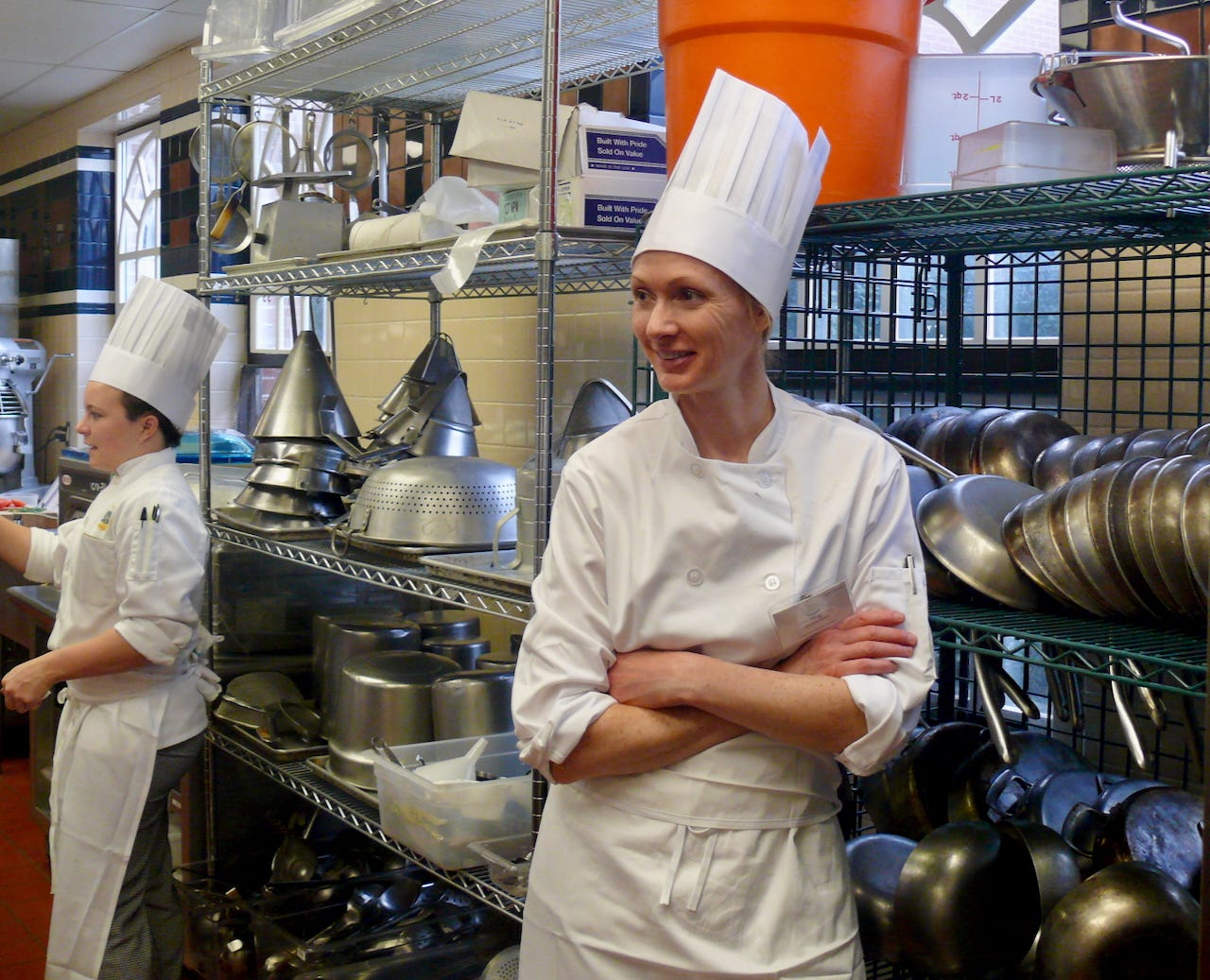

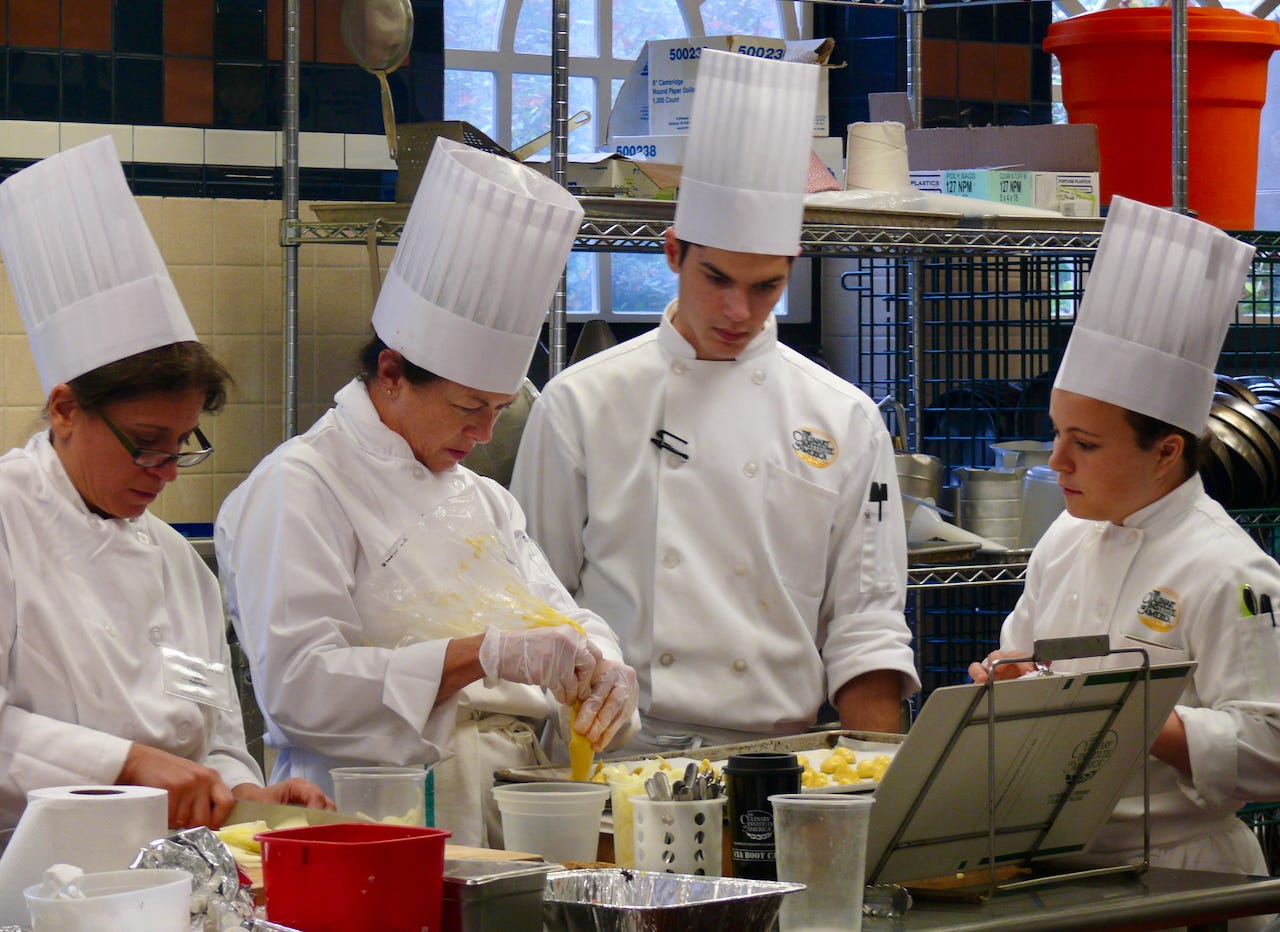

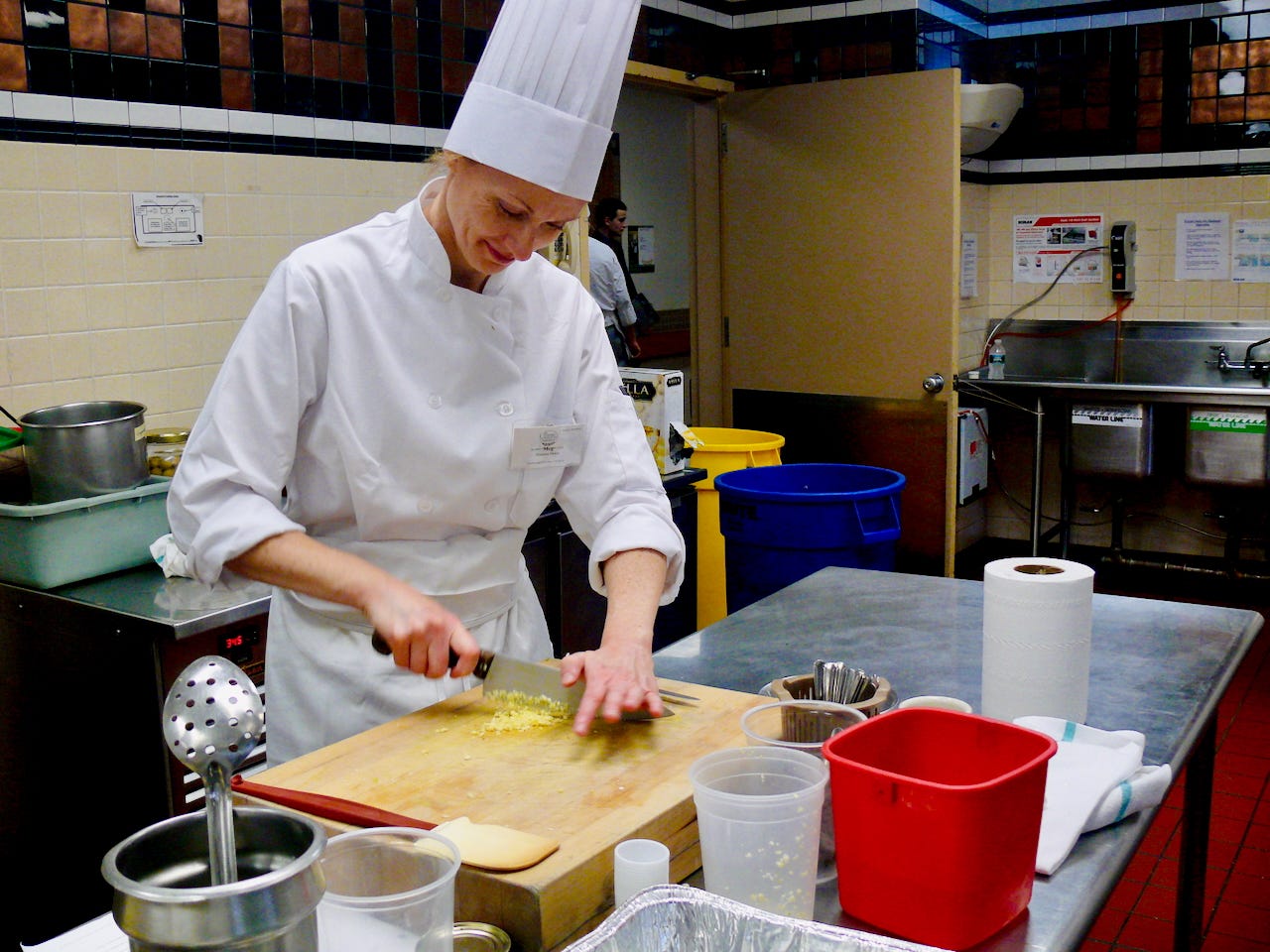
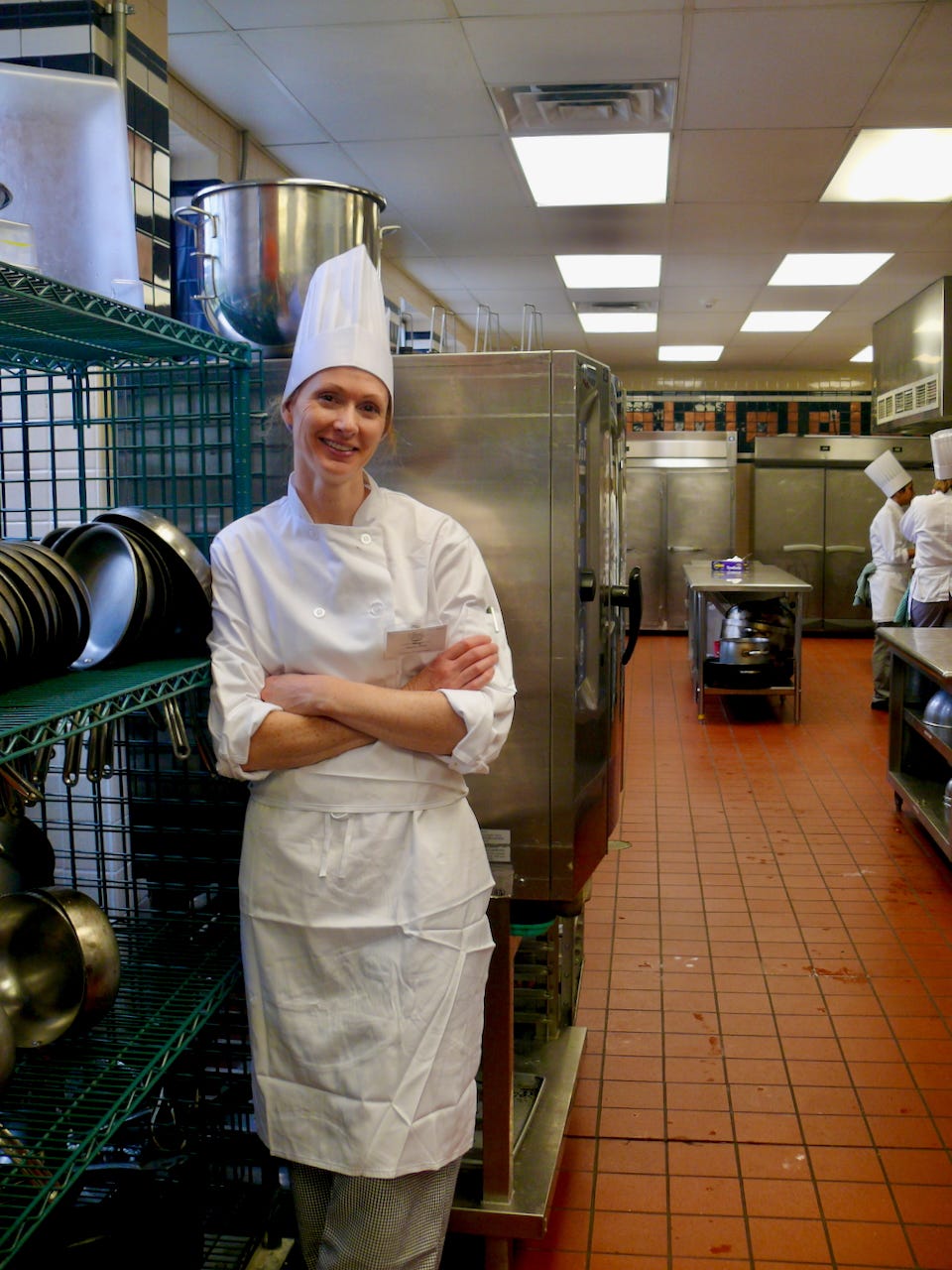
Meg! How fun to read this! I love it, and seeing the pictures reminds me of the wonderful time we had together taking this course. Thank you for this special Birthday present!! We both have milestone birthdays this year, 4 weeks apart. You are a very treasured friend. Perhaps we should take ourselves to CIA again to celebrate our love of cooking and our friendship.
Very interesting. Laura and I did several weekend “hobbyist” classes (and one week long) at NECI, and only the week long really taught more than very basic things. I suspect they know that it’s a small percentage of the willing who are actually able to handle the intensity.